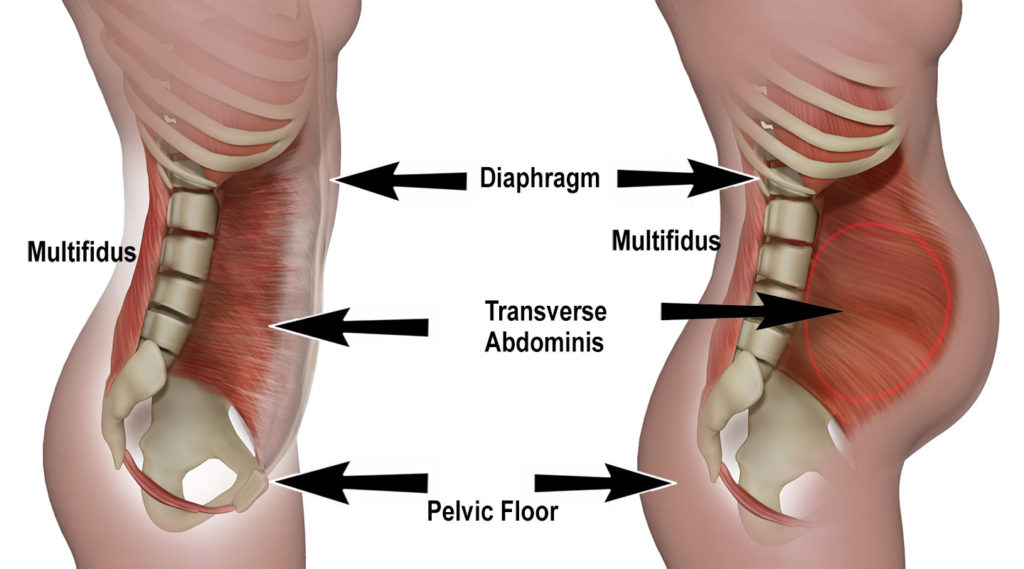
The pelvic floor is the bottom of your core. This somewhat elastic, sling-like system can weaken during pregnancy and labor. Think of it as a hammock that holds your bladder and reproductive organs in and attaches to the front and back of your pelvis. Its primary job is to keep that baby in and then afterwards to keep your insides … well … in. These muscles work all day long and in conjunction with the TA to stabilize the core. Any insufficiencies in these muscles can cause pain, incontinence, and altered movement.
A study by Poświata in 2014, found that 45.54 percent of the 112 elite female endurance athletes (runners and cross-country skiers) polled suffered from incontinence. It is so common ladies! Researchers also determined that running and high-impact aerobics were the most identified sources of the incontinence. As a result, high-impact aerobics became the single most abandoned type of exercise once women had experienced loss of urinary control. The good news? These muscles can be trained! In order to strengthen any muscle you have to load it—that means that you have to work it beyond the point of its previous condition.
You never want to subtract to add—in other words, don’t put your pelvic floor at risk to start adding miles. If you have good core strength and stabilization, you can progress through the following recommendation more rapidly, otherwise spend 2–3 weeks at each stage. Starting running too soon can wreak havoc on your pelvic floor. Make sure you properly warm up (walking) and cool down (walking and stretching).
Find more information about how running impacts your pelvic floor and core (and what you can do about it) in our Running Guide.
Pregnant moms: read our top 10 tips for running during pregnancy.
Postpartum moms: start super slow, and not before two months postpartum UNLESS you have been super consistent with activating your transverse abdominis and pelvic floor. If you are a hardcore runner, you have a little more grace in that you can start running 6 weeks post a vaginal delivery (given your doctor agrees).

Our DPT and pelvic floor specialist covers Pelvic Floor Exercises in a 5-part series in our studio.
Incorporate daily pelvic floor exercises. As always, it’s important to incorporate strength and flexibility into any running routine. I recommend our workout schedule for Athletes. Because running happens in one plane of motion, it’s a must that you strengthen your core and all the muscles that move in the lateral direction (e.g., gluteus medius). This will keep your body healthy!
Kegel exercises, like hold ’ems, have been shown to support proper pelvic alignment; prevent prolapse of the bladder, uterus, and rectum; realign the pelvis; support sphincter control; improve circulation to the pelvic floor muscles; and establish a healthy environment for healing.
The Kegel exercise is one of the best ways to identify and isolate these muscles. Remember that in order to strengthen any muscle you have to load it—that means that you have to work it beyond the point of its previous condition.
If you are experiencing pelvic pain, don’t push through. You might need to modify your workouts. If you have an abdominal separation (diastasis recti), we have a handful of guidelines you need to follow. Check out Running with Diastasis Recti.
If you haven’t already, incorporate core stability exercises into your routine. Check out our Functional Core Routine for runners or download our Running Guide, which also includes the pelvic floor exercises mentioned above.
A few considerations for your running program:
• Are you able to stabilize your core? All of the internal muscles we’ve talked about help stabilize your core.
• Have you integrated full-body strength training? Specifically exercises that take you into different planes of motion. We spend a lot of time in one pattern while running, so we need to strengthen all those stabilizing muscles in different planes.
• And stretching? Always an important part of any exercise routine. Did you know tight chest muscles can move down the kinetic chain and cause knee/hip pain while running?
• I recommend pairing your running routine with our athlete workouts. The perfect combination of cross-training and firing up the inner core muscles.
The Moms Into Fitness Studio is packed full of safe and effective workouts to supplement your running. Give our Running Programs a try.
Duvall, S. Can I Run with a Diastasis? Retrieved from https://www.coreexercisesolutions.com/can-i-run-with-a-diastasis/
Lee, D. Diastasis rectus abdominis & postpartum health consideration for exercise training. Retrieved from https://dianelee.ca/articles/Diastasis-rectus-abd.pdf
Nixon, J., Goom, T. Running, incontinence and pelvic floor exercises. https://www.running-physio.com/pelvic-floor/
Poswiata, A., Socha, T., Opara, J.(2014). Prevalence of Stress Urinary Incontinence in Elite Female Endurance Athletes. Journal of Human Kinetics, 44, 91-96.